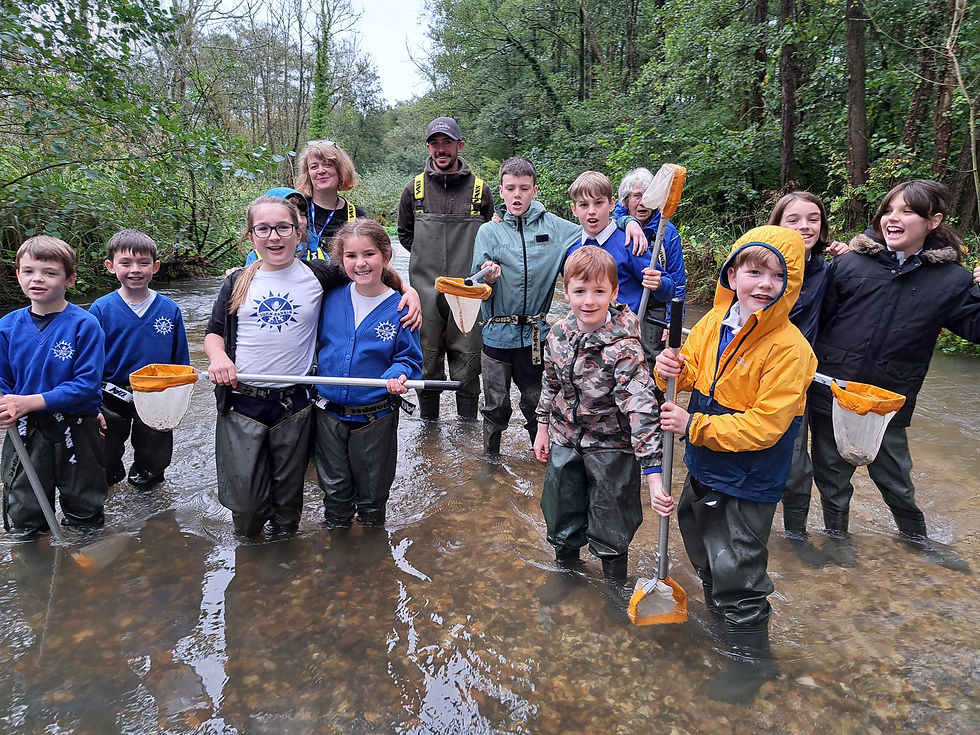John Rankin Junior School
- River Thames Salmon School
- Dec 16, 2024
- 2 min read

Species we uncovered in River Kennet
Abramis brama – Common bream
Anatidae – Waterfowl, unidentified
Anguilla anguilla – European eel
Barbatula barbatula – Stone loach
Barbus barbus – Common barbel
Bos taurus – Domestic cow
Cottus sp. – Sculpin, unidentified
Esox lucius – Northern pike
Gasterosteus aculeatus – Three-spined stickleback
Lampetra sp. – Lamprey, unidentified
Leuciscus leuciscus – Common dace
Lissotriton vulgaris – Smooth newt
Oncorhynchus mykiss – Rainbow trout
Ovis aries – Domestic sheep
Perca fluviatilis – European perch
Phoxinus phoxinus – Eurasian minnow
Pungitius sp. – Nine-spined stickleback, unidentified
Rutilus rutilus – Common roach
Salmo trutta – Brown trout
Squalius cephalus – European chub
Thymallus thymallus – European grayling
John Rankin Primary School’s student Eco Committee were thrilled to join The Salmon
School in 2024 through three hands on workshops led by Action for the River Kennet (ARK),
one of 6 Rivers Trusts delivering the project for 5 schools in England in the Thames
catchment through a partnership with Thames Rivers Trust and The Salmon School.
The Newbury, Berkshire-based school is fortunate to be situated close to two internationally
rare chalk streams, the Lambourn and the Kennet. After an introductory workshop to the
project and discovering how important Atlantic salmon are to our river ecosystems, the Eco
Committee children got to spend a day with ARK and a River Keeper in and by the River
Kennet, a Site of Special Scientific Interest (SSSI).
Here they immersed themselves in nature and experienced how special their local river is —
and saw the wealth of species that live here, as well as learning about the pressures their
rivers are facing, from pollution to invasive non-native species and the issues they cause.
During the day children took on two citizen scientist roles, invertebrate kick sampling to find
and identify freshwater river life that are good water quality indicators; and environmental
DNA collection, to discover what lives in the chalk stream and perhaps was not seen.
During the field trip the students created their own wonderful artwork from observations at
the river, including the tiny but vital invertebrates they found in the gravel riverbed which are
the primary food source for fish and much other wildlife. The children embraced mixing soil
from the riverbanks with water from the river to make natural paint, that would contain eDNA.
Anna Forbes, ARK Senior Project Officer shared, ‘The Eco Committee have learnt so much
through the opportunities associated with this fantastic project. The children are now
ambassadors for the Atlantic salmon and healthy rivers. They have experienced high quality
outdoor education with local experts to really connect with their local river and its wildlife and
gain an understanding of the plight of the iconic Atlantic salmon. Although no salmon were
picked up in the eDNA samples 17 fish species were, including salmonids, the brown trout
and grayling. Both species that like the salmon, depend on cold, clean water for survival.’








Comments